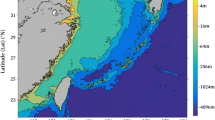Abstract
Currently, radial basis functions and support vector machines (SVM) are the best methods for big data modeling. SVM can approach any non-linear variable relationship with arbitrary precision, and deal with the complex laws between variables more appropriately. It provides new ideas and methods for the development of predictive models. The predictive accuracy is good, and all the results are satisfactory. Rivers, seas, and lakes accumulate sediments due to various objective reasons such as nature, and these materials may be deposited on land or in the ocean. Terrestrial deposits are formed on land, but sometimes they also accumulate on land, oceans, or lakes. Accumulation is the raw material of accumulation rock and may contain fossils of aquatic organisms. When these aquatic creatures die, they will be covered by accumulations. The deposits at the bottom of the lake that are not fossilized can be used to infer the previous climatic conditions. The university’s sports major is the training base for sports talents. With the progress of China’s school sports reform, the society urgently needs new sports talents with a solid foundation, extensive capabilities, strong self-confidence, and great innovation capabilities. Aerobics is a new sport in Chinese sports. It entered university physical education in the middle of the last century. It is now loved by most teachers and students and has become a common sport in university physical education. The physical education subjects of universities in the A area generally provide aerobics professional courses. With the deepening of education reform, many problems have appeared in the education content, which directly affects the training of bodybuilding talents and the sustainable development of aerobics.
















Similar content being viewed by others
Change history
04 November 2021
This article has been retracted. Please see the Retraction Notice for more detail: https://doi.org/10.1007/s12517-021-08715-7
28 September 2021
An Editorial Expression of Concern to this paper has been published: https://doi.org/10.1007/s12517-021-08471-8
References
Adam E, Mutanga O, Odindi J, Abdel-Rahman EM (2014) Land-use/cover classification in a heterogeneous coastal landscape using RapidEye imagery: evaluating the performance of random forest and support vector machines classifiers. Int J Remote Sens 35:3440–3458
Al-Mustansiriya J, SA MZ, Qazi W, Aslam N (2018) A comparative study of ALOS-2 PALSAR and Landsat-8 imagery for land cover classification using maximum likelihood classifier. Egypt J Remote Sens Space Sci 21:S29–S35
Amarsaikhan D, Saandar M, Ganzorig M, Blotevogel HH, Egshiglen E, Gantuyal R, Nergui B, Enkhjargal D (2012) Comparison of multisource image fusion methods and land cover classification. Int J Remote Sens 33:2532–2550
Ashkan MRH, Najmeh CS (2012) Speckle reduction approach for SAR image in satellite communication. Int J Mach Learn Comput 2:62–70
Badreldin N, Goossens R (2014) Monitoring land use/land cover change using multi-temporal Landsat satellite images in an arid environment: a case study of El-Arish, Egypt. Arab J Geosci 7:1671–1681
Ban Y, Webber L, Gamba P, Paganini M (2017) EO4Urban: Sentinel-1A SAR and Sentinel-2A MSI data for global urban services. In: 2017 Joint Urban Remote Sensing Event (JURSE), IEEE, pp 1-4
Breiman L (2001) Random forests. Mach Learn 45:5–32
Chatziantoniou A, Psomiadis E, Petropoulos G (2017) Co-orbital Sentinel 1 and 2 for LULC mapping with emphasis on wetlands in a Mediterranean setting based on machine learning. Remote Sens 9:1259
Cho MA, Debba P, Mutanga O, Dudeni-Tlhone N, Magadla T, Khuluse SA (2012) Potential utility of the spectral red-edge region of SumbandilaSat imagery for assessing indigenous forest structure and health. Int J Appl Earth Obs Geoinf 16:85–93
de Leeuw LMTdC Markus Robertus (2009) Performance evaluation of several adaptive speckle filters for SAR imaging Anais XIV Simpósio Brasileiro de Sensoriamento Remoto, Natal, Brasil, 25-30 abril. INPE, p 7299–7305
Erinjery JJ, Singh M, Kent R (2018) Mapping and assessment of vegetation types in the tropical rainforests of the Western Ghats using multispectral Sentinel-2 and SAR Sentinel-1 satellite imagery Remote. Sens Environ 216:345–354
Foody GM (2002) Status of land cover classification accuracy assessment. Remote Sens Environ 80:185–201
Goodman NR (1963) Statistical analysis based on a certain multivariate complex Gaussian distribution (an introduction). Ann Math Stat 34:152–177
Hansen MC, Loveland TR (2012) A review of large area monitoring of land cover change using Landsat data. Remote Sens Environ 122:66–74
Jos'e A. Apolin’ario Jr SLN (2009) QRD-RLS adaptive filtering. Springer Science+Business Media
Joshi N, Baumann M, Ehammer A, Fensholt R, Grogan K, Hostert P, Jepsen M, Kuemmerle T, Meyfroidt P, Mitchard E, Reiche J, Ryan C, Waske B (2016) A review of the application of optical and radar remote sensing data fusion to land use mapping and monitoring. Remote Sens 8:70
Landis JR, Koch GG (1977) The measurement of observer agreement for categorical data. Biometrics 33:159–174
Leinenkugel P, Wolters ML, Kuenzer C, Oppelt N, Dech S (2014) Sensitivity analysis for predicting continuous fields of tree-cover and fractional land-cover distributions in cloud-prone areas. Int J Remote Sens 35:2799–2821
Lin X, Sun L, Li Y, Guo Z, Li Y, Zhong K, Wang Q, Lu X, Yang Y, Xu G (2010) A random forest of combined features in the classification of cut tobacco based on gas chromatography fingerprinting. Talanta 82:1571–1575
Mahboob Iqbal JC, Yang W, Wang P, Sun B (2013) Sar image despeckling by selective 3D filtering of multiple compressive recon-structed images. Electromagn Waves (Camb) 134:209–226
Mohammed Noori A, Hasan SF, Ajaj QM, Ridha Mezaal M, Shafri HZM, Shareef MA (2018) Fusion of airborne hyperspectral and WorldView2 multispectral images for detailed urban land cover classification a case study of Kuala Lumpur, Malaysia. Int J Eng Tech 7:5
Motiur Rahman SR, Islam A, Rahman M, Talukder MH (2013) A new filtering technique for denoising speckle noise from medical images based on adaptive and anisotropic diffusion filter. Int J Res Comput Communi Tech 2:689–693
Van YH JL (1996) Evaluation of several speckle filters techniques for ERS1 and 2 imagry Int Arch Photogramm. Remote Sens Spat Inf Sci XXXI:164–169
Zhou KZMH (2008) An impulsive noise color image filter using learning based color morphological operations. Digit Signal Process 18:406–421
Author information
Authors and Affiliations
Corresponding author
Ethics declarations
Conflict of interest
The author declares no competing interests.
Additional information
Responsible Editor: Sheldon Williamson
This article is part of the Topical Collection on Environment and Low Carbon Transportation
This article has been retracted. Please see the retraction notice for more detail: https://doi.org/10.1007/s12517-021-08715-7
About this article
Cite this article
Liu, M. RETRACTED ARTICLE: Optimization of marine biological sediment and aerobics training mode based on SVM. Arab J Geosci 14, 1503 (2021). https://doi.org/10.1007/s12517-021-07838-1
Received:
Accepted:
Published:
DOI: https://doi.org/10.1007/s12517-021-07838-1




